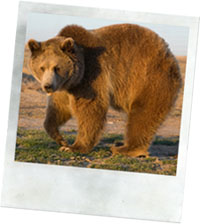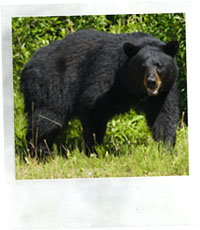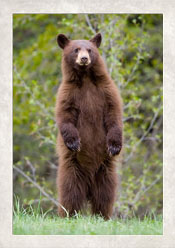Canmore wildlife - bears

If you live in Alberta then there is a good chance that you live in bear territory, although not all of Alberta is inhabited with bears. This means that us as humans need to learn to be bear aware and try to minimise negative bear-human encounters.
There are two species of bear in Alberta, the grizzly bear and the black bear. Most bears are usually quite shy and they will quickly vacate the area if they hear humans, however some bears do exhibit aggressive characteristics, possibly from previous negative bear-human encounters, and in these cases incidents can sometimes occur.
The possibility of bear-human encounters should not put anyone off enjoying all that the great Canadian outdoors has to offer as these encounters are rare, and as long as you are bear aware then both humans and bears should be able to share and enjoy the wilderness.
What's the difference between grizzly and black bears?

Grizzly bear
Grizzly bears:
- have a pronounced hump on their shoulders
- may have silver or light-tipped guard hairs on their head, shoulder hump and back
- can range in colour from blonde to black
- ears are rounded and quite small
- nose looks pig like
- claws are long, 7.5-10 cm long, and may have a light coloured strip
- can be smaller than some black bears

Black bear
Black bears:
- appear more uniform in colour
- can range in colour from blonde to black
- ears are pointed and quite noticeable
- nose looks dog like
- claws are short, 2.5 cm, and usually black
- can be larger than some grizzly bears
How do I know if there's a bear about?
- bear scat, especially if fresh
- bear trails/tracks, as they are creatures of habit they like to return to familiar areas creating known routes
- rubbed, chewed and clawmarked trees, torn stumps
- diggings, buried carcasses and torn open ant hills
- rolled logs and rocks, in their search for insects to eat
What do bears eat?
Bears are omnivores which means, like humans, they eat animal and plant foods. The difference is however that bears are opportunistic and will eat almost anything, from toothpaste to cereal, your dinner to other wildlife. As bears are scavengers they will investigate and rummage through any potential food source, and have also learnt that wherever humans are there's a good chance that food is not far away.
Living with bears in Canmore:
Living in bear country means that you need to be bear aware at all times, if you are then you minimise the chance that you will have a negative bear-human encounter. On May 1, 1999 Canmore introduced a complete animal proof waste collection system.
- always keep your garbage in a secure place that bears can't get access to, garbage should never be burned, dispose of it in animal proof waste containers or sanitary landfills
- household items such as food, cooking utensils, pet dishes, bar-b-ques etc should always be kept in a secure place that bears can't get access to, bar-b-que grills should be cleaned immediately after use
- fish parts, meat bones or other meat byproducts for the garbage should be kept in the freezer until they can be disposed of properly
- rinse all used food and beverage containers thoroughly to remove odours
- try to recycle as much of your waste as possible, recycling depots are located at: 115 Boulder Crescent (Elk Run Industrial Park)
- animal proof waste containers are conveniently located in all neighbourhoods of Canmore, they can be accessed at any time day or night for disposal of residential garbage
- DO NOT put hazardous waste into the containers, i.e. paint, oil, aerosols or liquids or any kind
- DO NOT throw cardboard into the containers as it takes up too much room, it's recyclable so should be disposed of properly
- DO NOT put residential waste into pedestrian waste containers
- do not leave pet food or empty pet food dishes outside
- only feed the birds using bird feeders between October 31 and April 1 each year, bears are attracted by the smell of birdseed, other animal attractants are not permitted at any time
- composting kitchen organic waste can attract attention from bears and is therefore prohibited, leaf, grass and garden waste composting is available to all residents using a large container located at 115 Boulder Crescent during the summer, no woody or commercial leaf and yard waste or plastic bags are allowed
- livestock feed/grain should be stored in sturdy sealed structure, preferably metal granaries
- any livestock or wildgame carcasses should be removed from your property, some of Alberta's rendering plants will offer free pickup
- if you have any livestock loss due to bear predation contact your nearest Alberta Sustainable Resource Development (SRD) office
- the minimum fine for violating the Canmore waste control by-law is $100 for the 1st offence, $200 for the 2nd, and $500 for the third and subsequent offences
- For more information: tel. 678-1580 or visit www.gov.canmore.ab.ca
Preventing bear encounters:

Day hiking, biking or fishing:
- make lots of noise, talk loudly, sing, shout, especially when approaching dense vegetation, blind corners, streams or moving into the wind
- if you see recent bear signs such as fresh scat, fresh diggings etc, turn around and go back the way you came, don't risk coming face to face with the bear
- whatever you pack in, pack out again in sealed bags
- leave your pet at home, or on a leash at all times, loose dogs attract and irritate bears, and will usually bring them back to you
- don't let your group split up, especially if you have children with you
- if you clean your fish while in the backcountry seal the fish in plastic bags and wash your hands thoroughly to remove fish odour, throw the entrails into the lake or stream after puncturing the air bladder
- bear bells are NOT very effective
Camping/campgrounds:
- NEVER take food or toilet articles (soap, deodorant, toothpaste etc) into your tent or tent trailer, store them in the trunk of your vehicle or special bear-proof storage
- seal all garbage into plastic bags and use the bear-proof bins to dispose of it
- never burn or bury scrap food, seal it into plastic bags and use the bear-proof bins to dispose of it
- water used for washing cooking and eating utensils or bathing should be disposed of in toilets or sealed in plastic bags and disposed of in bear-proof bins
- NEVER clean fish at your campsite, use designated fish cleaning stations
- if you take your pet with you camping then make sure they stay on a leash, a loose dog will come running back to YOU, sometimes with a bear in hot pursuit
- don't let young children roam, keep them close by, especially at dawn, dusk and night
- at night move cautiously around your campsite and use a flashlight
Backpacking:
- follow all the precautions listed above for day hiking, biking and fishing
- never travel alone in the backcountry
- leave your destination and estimated return time with someone, either friends, family or the authorities
- only use designated backcountry campgrounds or camp in open areas away from streams, lakeshores and game trails
- use dried foods
- using a portable camp stove ensure that your cooking area is at least 100m from your sleeping area, this will prevent food odour contamination of your sleeping area/equipment
- NEVER sleep in the clothes that you have worn while cooking
- store cooking utensils and food at least 100m from your tent, this decreases the chance that you'll be in the way of a hungry bear checking out your food supply
- hang all food, garbage and equipment in a tree to discourage bears from investigating them, choose a tree with strong limbs at least 3m above the ground, attach a rock to the end of a rope and throw it over the branch, tie the end of the rope to the food, garbage and equipment and then pull the load up to just underneath the branch, securely fasten the other end of the rope to the tree in at least two places
- always pack out your garbage, never burn food scraps, remember whatever you pack in, pack out again in sealed bags
Hunting:
- make sure you remove the carcass in one trip, or if that's not possible, in one day
- when you return to the kill site do so very cautiously making a lot of noise, you should be aware that your kill may have attracted a bear
- if there is a bear at your kill site DO NOT try to chase it away, leave the carcass to the bear, leave the site and report the incident to the nearest Alberta Sustainable Resource Development (SRD) office
- if you have to leave the carcass hang it at least 100m from your camp, and use extreme caution when you re-approach it
What do I do if I encounter a bear?
There aren't any hard and fast rules about how to act in a bear encounter, the best course of action initially is to take as many precautions as you can to avoid bear encounters in the first place. However if you do encounter a bear no two situations will be the same, as bears react to people in different ways depending on the situation, the season, whether they have bear cubs with them, whether they are hungry, or if there is an escape route available to them.
- NEVER run, running may excite the bear, it may then consider you prey and attack, you will never outrun a bear as they can cover short distances at up to 65 kph
- if your vehicle is close by get into it as quickly as possible
- if you have no vehicle then stay calm, size up the situation and check to see if the bear is a grizzly or a black bear
- slowly back away from the bear, if the bear continues to move towards you drop your backpack or any other belongings which may distract the bear into investigating them rather than you
- do not harass the bear or try to chase it
- if there are bear cubs in the area slowly move away from them, as far as possible, DO NOT stop for a photo opportunity
- if the bear has cubs or is non-charging then you should try to appear very passive, DO NOT make loud noises, raise your voice or scream
- if the bear is a grizzly and there is a climbable tree nearby, climb as high as possible, and at least to a height of 10m, although some grizzly bears have been known to go much higher, if the bear is a black bear climbing a tree is not going to necessarily help as they are agile climbers
If a bear charges you:
- the first thing YOU should do is act and appear NON-THREATENING, the bear may simply be carrying out a "bluff charge" to establish it's dominance and then may retreat, although it may carry out several "bluff charges before an encounter ends
- experts advise standing your ground and speaking to the bear in a normal voice, this ensures that the bear knows that you are there, and also that you are human
- NEVER stare directly at a bear as they will perceive this as a threat, avert your eyes
- if the bear continues to charge and gets closer you could try to intimidate the bear by making direct eye contact, also jumping up and down and shouting, or it you have it by using pepper spray (make sure you are familiar with the operation of pepper spray before you are called to use on it in an encounter)
If you are in a predatory situation:
- a predatory situation is where the bear appears to be stalking YOU as potential prey, most serious black bear attacks are predatory
- adopt a DOMINANT stance, make DIRECT eye contact, SHOUT at the bear, act in a DEFIANT manner
- if a predatory attack does happen act in a DOMINANT manner and use any available WEAPON you can find, for example sticks, stones, pepper spray or even your fists, to fight off the bear
- if you make contact with a non-predatory grizzly, for example surprising a bear, drop to the ground with your face down, interlace your fingers at the back of your neck and spread your legs to make it harder for the bear to flip you over onto your back
- night-time attacks are potentially predatory situations so you must always fight back using anything as a weapon that you can lay your hands on or your fists
Prevention of negative bear-human encounters is the best option for you and the bear, and it is your responsibility if you live, work or recreate in their habitat to learn as much as you can about bears, bear behaviour and bear-human encounter behaviour. By doing this you can minimise the chance of encounters and keep both you and the bears safe.
There are books, websites and courses available on being bear aware, they are designed to help you and the bears.
If you do encounter a bear then you should report any incident to the nearest Alberta Sustainable Resource Development (SRD) office.
If you encounter a problem bear notice while in the backcountry you should leave the area immediately as it is illegal to enter an area that has been closed to the public. If you cross into this area and you are caught you will receive a fine, or you may just encounter that problem bear you were warned about.
You may rarely come across a bear trap designed to capture a nuisance bear for removal elsewhere, if you do, DO NOT approach it.
As a last resort bears are occasionally destroyed when they become repeat offenders, having lost their fear of humans, or if there is nowhere nearby that is safe to relocate them to. To avoid this terrible loss to the bear population and traumatic act being carried out, using the correct bear avoidance techniques will keep you and the bears free to roam and enjoy the Canadian wilderness.
For more information about bear-human encounters contact any Parks or SRD office or visit Grizzly Bear Alliance, Get Bear Smart Society, Bear Aware British Columbia, Google has many more bear sites available to browse and while they don't all relate to Alberta they relate to bears, so valuable lessons can still be learnt because a bear is still a bear even though it may live outside Alberta.
Remember, and you will still be able to enjoy the Canadian outdoors in harmony with its bear population:
- NEVER feed or approach a bear
- ALL bears are dangerous, DO NOT be deceived by their cute, cuddly looking appearance
- female bears with cubs will always protect their young, VERY aggressively
- give them a WIDE berth, they can run up to 65 kph, that's faster than you
